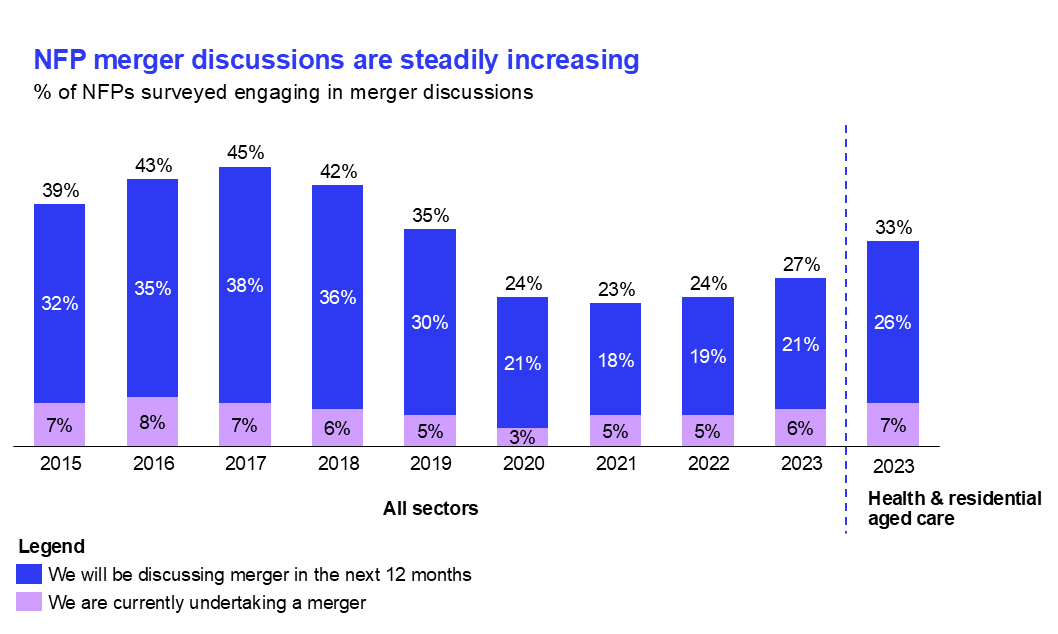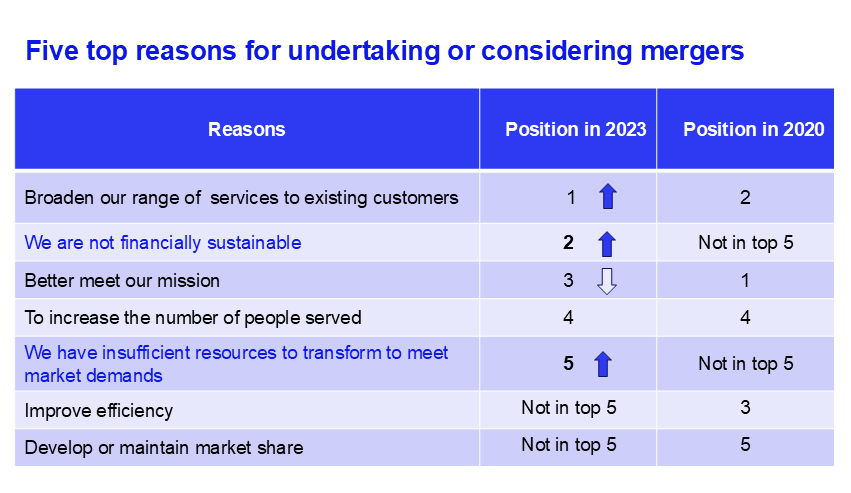
The four questions to ask when considering a merger
Merger options should be a part of every not-for-profit’s (NFP’s) strategic discussions. Here, we set out why, and outline how to think through whether a merger may be right for you.

- Mergers in the NFP sector have started to increase again since 2020/21.
- Merging is the right choice if it will increase the impact your organisation can achieve.
- This article sets out the four questions a board and leadership should consider in deciding whether to pursue a merger.
- These questions reflect the focus on impact: understanding how you make impact and how your impact could be increased. They also consider the resources, capabilities and commitment required to make a merger work.
We are often asked by NFPs we work with whether they should be considering a merger. In this article we outline how to tackle that question in two parts:
- The importance of considering mergers: we explore the prevalence of mergers in the NFP sector and why it is important to actively consider mergers as part of your strategic discussions.
- Four questions to guide your decision: we take you through four questions to help you consider whether a merger is the right move for you:
1. What impact do you create and how?
2. How would a merger help increase your impact?
3. How do the alternatives compare?
4. What would it take to successfully execute?
The importance of considering mergers
The opportunity to increase impact for their clients should motivate NFPs to actively explore strategic opportunities for improvement, including mergers.
After a dip in NFP merger discussions due to the uncertainty driven by the pandemic and sector reforms, since 2020/21 merger discussions are steadily increasing (see figure 1).1 The health and residential aged care sector stands out in particular with 33% of NFPs in merger discussions in 2023 compared to 27% for the broader NFP sector.

We are often asked by NFPs we work with whether they should be considering a merger. Our answer is yes. While pursuing mergers comes with risks, when done successfully, the impact can be enormous.2 Moreover, they can be a means to remain competitive with for-profit providers and to sustainably continue to deliver quality outcomes that often exceed that of for-profit providers.3 The opportunity to increase, or sustain, their impact should motivate NFPs to include merger considerations as a standard topic in their strategic discussions – just as it is for for-profit organisations.
Four questions to guide your decision
Pursuing a merger is the right choice if the merger will increase your impact.
To know whether pursuing a merger is the right move, we suggest considering the four questions below. Importantly, reflecting on not only the current context, but also likely future scenarios – including a potentially much more consolidated and highly regulated sector.
1: What impact do you create and how?
Mergers can be risky, complicated and lengthy transactions with many moving parts to consider (see this guide). The overriding principle that needs to govern all trade-offs and decision-making is whether the merger will increase the impact that your organisation can achieve. For this reason, the first question to ask is: what is the impact that you strive to create with your organisation? As a part of answering this question, it is important to be clear on how you are able to achieve your impact. What are your distinctive capabilities (i.e., what do you do exceptionally well) that enable you to achieve this impact?
For example, Reconciliation Australia exists to promote and facilitate reconciliation by building relationships, respect and trust between the wider Australian community and Aboriginal and Torres Strait Islander peoples. They are uniquely positioned to do this, given (amongst other strengths) their distinctive capability to build trusted relationships with a large range of diverse organisations at different stages on their journey towards reconciliation.
‘This lack of standardisation makes it hard to directly compare performance versus peers…’
The next step would be to understand how well you do in achieving your impact, and how this compares to others. This is often where it gets a little tricky. NFPs typically measure success through impact metrics – such as number of people impacted and outcomes to those beneficiaries. These metrics differ greatly across organisations. This lack of standardisation makes it hard to directly compare performance versus peers and identify areas where you excel and where you could improve. However, even if the perspective is only indicative at first, knowing your main peers and understanding what they do better or less well than you is critical to understanding how you can better achieve your impact.
2: How would a merger help increase your impact?
Typically, there are three ways in which a merger may increase your impact (or sustain impact that you are challenged to maintain): through enhanced capability and capacity, improved financial health, and a stronger advocacy position.
The contribution of each of these factors depends on how you achieve your impact, as well as how you compare to peers. The role of each of these factors would influence what form of merger and what potential merger partners would be suitable. And of course, the ability to find a suitable partner and agree on the form of merger, will determine how much of these potential benefits you are able to realise.
- Enhanced capability and capacity: If you are clear on what you do exceptionally well towards achieving your impact (and what you do less well), you will be able to articulate what capabilities or assets may enhance your ability to increase your impact. For example, you could expand a successful model geographically, strengthen both organisations with complementary capabilities, or grow your capabilities by sharing expertise and learning from a larger base of insights.
For example, the merger of Australian Unity and myHomecare will expand Australian Unity’s Home Health business to serve an additional approximately 20,000 customers.4

“We take our community responsibility seriously and this acquisition allows us to expand the provision of in-home health and care services to thousands of Australians, ultimately helping people to live well and independently for longer and reducing pressure on healthcare and residential aged care sectors.”Prue Bowden • Australian Unity’s Group Executive – Home Health.
- Improved financial health: Bringing two organisations together could create financial efficiencies by removing duplication and leveraging scale in support functions (e.g., admin and finance support, understanding implications of regulatory changes, quality assurance, government reporting, rostering). In addition, financial capacity could be created by avoiding duplication of future technological investments. For many NFPs, customer experience, service quality and impact are directly linked to frontline/customer-facing support, therefore realising efficiencies in those teams is typically not an option.
Improved financial health would contribute to increasing your impact by supporting long-term financial sustainability and by enabling investments in service or product quality as well expanding the number or type of clients reached.
For example, the merger of House with No Steps and The Tipping Foundation into Aruma aimed to transform the organisations effectively and efficiently in response to changing dynamics in the disability sector.5

“Together, we could invest and share resources to ensure quality and consistency of service delivery; attract, develop, and retain great staff. We could also implement new technologies to make it easier to engage with us and the NDIS easier to navigate.””Andrew Richardson • CEO of Aruma.
- Stronger advocacy position: In some cases, merging with another organisation may give an organisation a stronger advocacy position and more leverage to increase their impact. This could be by making a stronger case to funders (including government, philanthropy, other donors) or by getting a seat at the table in critical policy and advocacy discussions.
For example, growing a stronger voice to champion sustainable solutions in the aged care market was one of the drivers for the merger of Baptcare (Vic, Tas, SA), Baptist Care SA and BaptistCare (NSW, ACT, WA) into BaptistCare, Australia’s third largest integrated care and service provider.6

“This merger is about much more than pooling resources; it’s a bold but necessary step to amplify our advocacy and impact at a time when Australians need it most. With increasing demand for services and mounting regulatory pressures, BaptistCare is uniquely positioned to champion sustainable solutions, from aged care to affordable housing and homelessness, to retirement living.”Charles Moore • CEO of BaptistCare.
According to yearly Australian Institute of Company Directors’ (AICD) studies, primary drivers for NFP merger activity over the last few years have consistently been related to enhanced capability and capacity (better meeting mission, broadening the range of services, and increasing the number of people served). Increasingly, elements related to improved financial health (financial sustainability pressures and insufficient resources) have become important drivers as well: in 2020, these two financially related drivers didn’t make it to the top five reasons for mergers whereas, they took 2nd and 5th position in 2023 (see figure 2).7

3: How do the alternatives compare?
Merging is not the only way to improve your impact, and it does come with a significant amount of risk and investment of resources. Are there alternative strategies to achieve these outcomes?
For example, what efficiencies could be realised by improving internal back-office processes? What would the organisation look like if you were to truly focus only on what you’re really good at, and divest other activities to other organisations who are better placed in those areas?
Are there other forms of partnership (for example setting up an association or joint service delivery) that could realise similar benefits to merging and come with lower risk? Thinking through these questions will help you determine whether or not a merger is the most fitting pathway.
For example, one of SVA’s clients sought support in exploring opportunities to improve their financial health through scale, including via mergers and acquisitions. As we assessed the financial performance of their various services, we identified inherent costs that would not be resolved by a merger. As a result, the board decided to shift its focus to improving the inherent cost structures before considering expansion – which they have now accomplished.
In the NFP world, mergers and acquisitions (M&A) are often referred to only as ‘mergers’ to emphasise the collaborative blending of two organisations’ purposes and resources for the greater good, as opposed to the idea of one organisation ‘acquiring’ or taking over another. However, as part of the strategic considerations all forms of ‘mergers’ would be important to consider: true ‘mergers of equals, acquisition of another organisation, as well as being acquired by another organisation to enable longer term continuity or improvement of social impact due to increased scale or other benefits.
4: What would it take to successfully execute?
Mergers are no small feat. They can be risky, multi-year journeys that require a significant amount of investment. Success requires access to financial resources, a strong commitment from both (or all) organisations, and the right capabilities to lead the organisations through merger exploration and implementation. Before launching onto this journey, it is important to reflect on whether you have the required means to succeed. And ultimately, if on balance the effort would increase the impact of your merged organisation.
‘… considering structural changes like mergers can feel personal, especially for board members with long tenures and deep personal commitments…’
- Financial resources
The costs associated with a merger are considerable and often span multiple years. Major costs include investments in preparing for the merger (including external support such as legal advisory) as well as the costs of integrating the organisations and investing in benefit realisation. NFPs, unlike for-profit organisations, typically lack the financial reserves needed to cover these expenses and require creative solutions, such as acquiring philanthropic support or impact investing. While this is not yet common practice in Australia, it is increasingly so in for example the USA, with funders positively responding to strong cases for increased impact and value for money created by mergers. - Capabilities
Successfully executing a merger demands the right capabilities to manage the process – from initial exploration through to final execution. This includes negotiating the terms of the merger, building the business case, performing due diligence, coordinating efforts such as legal advisory, stakeholder management, risk management, stakeholder communications, and driving integration of the organisations, including benefit realisation and change management. NFPs often don’t have in-house expertise in mergers and have to source support externally. - Commitment
Finally, merger success is only possible if boards and CEOs are deeply committed. Firstly, it is important to be invested in the time commitment required, which can be significant. Secondly, it is critical to be committed to set aside personal egos for the greater purpose. In most scenarios, board positions will be impacted and at least one CEO is likely to lose their role. Moreover, considering structural changes like mergers can feel personal, especially for board members with long tenures and deep personal commitments to the organisation’s activities and ways of working. Successful mergers depend on the ability to check your ego at the door and stay focused on the larger purpose: increasing your impact (see also article Mergers and acquisitions: Four things for boards to keep in mind).
Conclusion
We are often asked by our clients whether they should be considering a merger. Our answer is yes: the objective to increase impact should motivate NFPs to actively consider all strategic opportunities for improvement, including mergers. Whether a merger is something to pursue can be assessed by the answers to the four questions above. Ultimately, merging is the right choice if it will increase the impact of your organisation.
1 Australian Institute of Company Directors, 2024, Yearly Not-for-Profit Governance & Performance Study, Australian Institute of Company Directors, 2015 – 2024, accessed 26 February 2025. Number of NFPs surveyed varies per year, with minimum 950 NFPs in any one year.
2 For example, a study in the USA found that 88% of organisations involved in mergers felt that the merger led to improved success in achieving organisational goals and increasing impact Haider, D., Cooper, K., Maktoufi, R.,2016, Mergers as a strategy for success: Strengthening the nonprofit sector in metropolitan Chicago, Metropolitan Chicago Nonprofit Merger Research Project, accessed 27 February 2025. Findings based on analysis of 25 not-for-profit mergers between 2004 and 2014 in the region
3 For example, in the early learning sector, not-for-profit provide
rs on average demonstrate better quality performance, with 28% of not-for-profit long day care providers rated above the National Quality Standard, compared to just 15% of for-profit. Sources: ACECQA, 2024, National Quality Standards and Mandala and the Front Project’s, 2024, Paving the Path: Addressing market imbalances to achieve quality and affordable childcare in more places
4 Australian Unity, 2024, Australian Unity completes myHomecare acquisition, Australian Unity Limited, 28 March 2024, accessed 25 February 2025.
5 Ferner D., Garrow, M., 2018, How to go about a non-profit merger, SVA Quarterly, Social Ventures Australia, 28 March 20218.
6 BaptistCare, March 2025, Three leading not-for-profit care and service providers finalise merger to strengthen support for Australian communities, BaptistCare Blog on baptistcare.org.au, 7 March 2025, accessed 7 March 2025.
7 Australian Institute of Company Directors, 2024, Yearly Not-for-Profit Governance & Performance Study, Australian Institute of Company Directors, 2020 – 2024, accessed 26 February 2025.
Interested in learning more about NFP mergers?
As a trusted NFP adviser, SVA Consulting has supported a range of organisations along their merger journey from initial explorative conversations through to merger implementation.
Read our articles:
How to go about a non-profit merger
Mergers and acquisitions: Four things for boards to keep in mind
A transformative merger BaptistCare, Baptcare and Baptist Care (SA) coming together.
Look out for further articles this year about how to go about NFP mergers, as well as reflections from NFP organisations on their merger journey. You can sign up for future Quarterly articles here.
Get in touch
If you want to learn more or understand how we may support you:
-
 Director, Consulting (NSW) Irmke Bonte
Director, Consulting (NSW) Irmke Bonte -
 Principal, Consulting (VIC) Divya Roy
Principal, Consulting (VIC) Divya Roy






